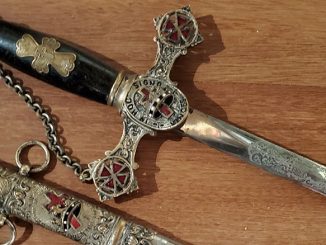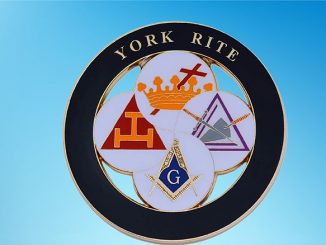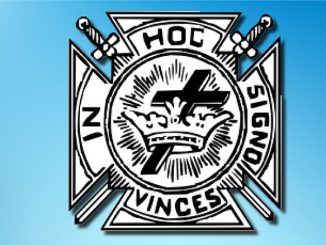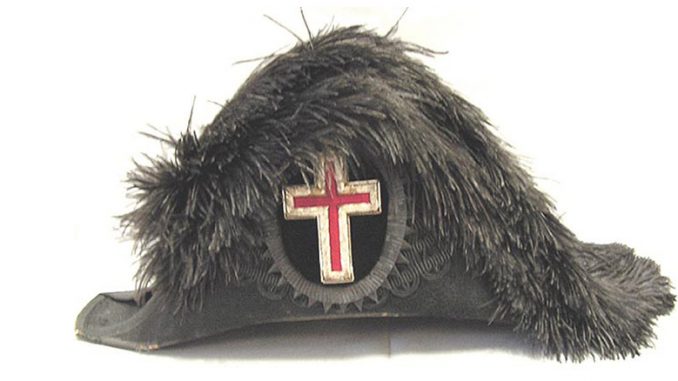
The regalia worn by the modern day Masonic Knights Templar is a harsh departure from that worn by the Templars of the middle ages. The sharpest contrast is in the amount of ornamentation on the sword. The Templar rule of order forbade any decoration on the Templar’s sword while a modern Templar sword is full of all sorts of carving, engraving and ornamentation.
While Masonic Templars in Canada and the US are similar in many respects the regalia or uniform they wear is quite different. The purpose of this page is to examine the two uniforms.
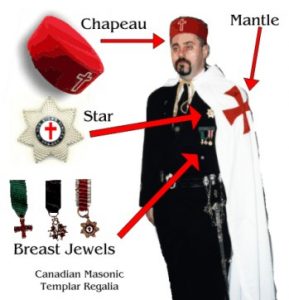 Canadian Templar Regalia
Canadian Templar Regalia
The Regalia of Canadian Masonic Templars has changed since the days of Colonel William James Curry McLeod Moore, Canada’s first Grand Prior (now called a Grand Master). Originally the Templars wore an apron as part of the Regalia as shown in the picture below depicting the founding of King Baldwin Preceptory No. 6 in Belleville, Ontario.
The original regalia depicted above also included a ceremonial sash showing the Skull and Cross Bones within a triangle, an emblem that will be familiar to the Masonic Templar as the “emblems of mortality.” Additionally the knights wore white satin gauntlets with a cross in red velvet thereon. This apron and sash remained a part of the Canadian regalia until it was abolished in 1873.
Mantle: The mantle is of white cloth with a large Red Cross Pattee over the left shoulder. This particular mantle is that of a Sir Knight. A Presiding Preceptor or Preceptor wears a similar mantle but with a single red stripe around the edge. Additionally the cross changes to a two-barred or patriarchal cross. This type of mantle is also worn by Grand Priory officers with the addition of two red stripes if an appointed officer (Very Eminent Knight) and three stripes if an elected Grand Priory officer (Right Eminent Knight). The Grand Master of the order wears a mantle trimmed in purple affixed with a three barred cross.
Chapeau or Cap: The chapeau is a red felt pillbox style cap of red felt with a Christian cross for a Sir knight and a Patriarchal Cross for a Presiding Preceptor or Preceptor. The Grand Master’s chapeau is, like his mantle purple in color and depicts the three barred cross of his office.
Seven Pointed Star: Is the emblem of the order and worn on the jacket above the heart. It is silver in the case of a Preceptory under 100 years of age and gold for those having passed a century of existence.
Jewel: The jewel hangs from the jacket pocket and depicts three different medals. One for each of the three orders (Not degrees as in other branches of Masonry) – The Illustrious Order of the Red Cross – The Order Of Malta – The Order Of The Temple.
Sword: Templar swords are discussed and shown in detail on another page of this Web Site and so will not be looked at in detail here, suffice to say that there are two basic styles. Nickel-plated sheath denotes a Sir Knight and a gold plated sword denotes a Presiding Preceptor or Preceptor.
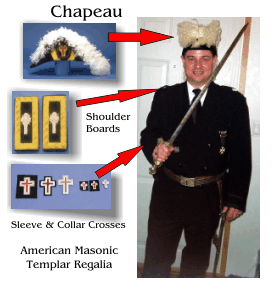 American Templar Regalia
American Templar Regalia
Compared to the Canadian Templar regalia, the American regalia is much more military in design and deserves the distinction of a uniform. The largest visible difference is in the design of the Chapeau, which is a naval style hat with feathered plume. A similar style of hat was worn in Canada for some time. As with the original order of Templarism, distinctions are made to designate rank. Sleeve and Collar Crosses are silver in the case of a Sir Knight and gold for a Past Commander. In the US Grand Commandery officers wear the Cross Pattee on sleeve and collar.
About Us
TemplarHistory.com was started in the fall of 1997 by Stephen Dafoe, a Canadian author who has written several books on the Templars and related subjects.
Read more from our Modern Templars Archives – Templar History

